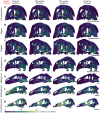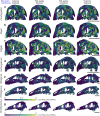Cranial functional specialisation for strength precedes morphological evolution in Oviraptorosauria
- PMID: 38600295
- PMCID: PMC11006937
- DOI: 10.1038/s42003-024-06137-1
Cranial functional specialisation for strength precedes morphological evolution in Oviraptorosauria
Abstract
Oviraptorosaurians were a theropod dinosaur group that reached high diversity in the Late Cretaceous. Within oviraptorosaurians, the later diverging oviraptorids evolved distinctive crania which were extensively pneumatised, short and tall, and had a robust toothless beak, interpreted as providing a powerful bite for their herbivorous to omnivorous diet. The present study explores the ability of oviraptorid crania to resist large mechanical stresses compared with other theropods and where this adaptation originated within oviraptorosaurians. Digital 3D cranial models were constructed for the earliest diverging oviraptorosaurian, Incisivosaurus gauthieri, and three oviraptorids, Citipati osmolskae, Conchoraptor gracilis, and Khaan mckennai. Finite element analyses indicate oviraptorosaurian crania were stronger than those of other herbivorous theropods (Erlikosaurus and Ornithomimus) and were more comparable to the large, carnivorous Allosaurus. The cranial biomechanics of Incisivosaurus align with oviraptorids, indicating an early establishment of distinctive strengthened cranial biomechanics in Oviraptorosauria, even before the highly modified oviraptorid cranial morphology. Bite modelling, using estimated muscle forces, suggests oviraptorid crania may have functioned closer to structural safety limits. Low mechanical stresses around the beaks of oviraptorids suggest a convergently evolved, functionally distinct rhamphotheca, serving as a cropping/feeding tool rather than for stress reduction, when compared with other herbivorous theropods.
© 2024. The Author(s).
Conflict of interest statement
The authors declare no competing interests.
Figures




Similar articles
-
Cranial muscle reconstructions quantify adaptation for high bite forces in Oviraptorosauria.Sci Rep. 2022 Feb 22;12(1):3010. doi: 10.1038/s41598-022-06910-4. Sci Rep. 2022. PMID: 35194096 Free PMC article.
-
An unusual oviraptorosaurian dinosaur from China.Nature. 2002 Sep 19;419(6904):291-3. doi: 10.1038/nature00966. Nature. 2002. PMID: 12239565
-
Elongatoolithid eggs containing oviraptorid (Theropoda, Oviraptorosauria) embryos from the Upper Cretaceous of Southern China.BMC Evol Biol. 2016 Mar 25;16:67. doi: 10.1186/s12862-016-0633-0. BMC Evol Biol. 2016. PMID: 27012653 Free PMC article.
-
Morphology and distribution of scales, dermal ossifications, and other non-feather integumentary structures in non-avialan theropod dinosaurs.Biol Rev Camb Philos Soc. 2022 Jun;97(3):960-1004. doi: 10.1111/brv.12829. Epub 2022 Jan 6. Biol Rev Camb Philos Soc. 2022. PMID: 34991180 Review.
-
The Endocranial Cavity of Oviraptorosaur Dinosaurs and the Increasingly Complex, Deep History of the Avian Brain.Brain Behav Evol. 2018;91(3):125-135. doi: 10.1159/000488890. Epub 2018 Aug 10. Brain Behav Evol. 2018. PMID: 30099460 Review.
References
-
- Osmólska, H., Currie, P. J. & Barsbold, R. In The Dinosauria 165–183 (2004).
-
- Pittman, M. et al. Pennaraptoran Theropod Dinosaurs: Past Progress and New Frontiers. Vol. 440 (American Museum of Natural History, 2020).
-
- Osborn, H. F., Kaisen, P. C. & Olsen, G. Three New Theropoda, Protoceratops Zone, Central Mongolia. American Museum Novitates144, 1–12 (1924).
MeSH terms
Grants and funding
LinkOut - more resources
Full Text Sources


